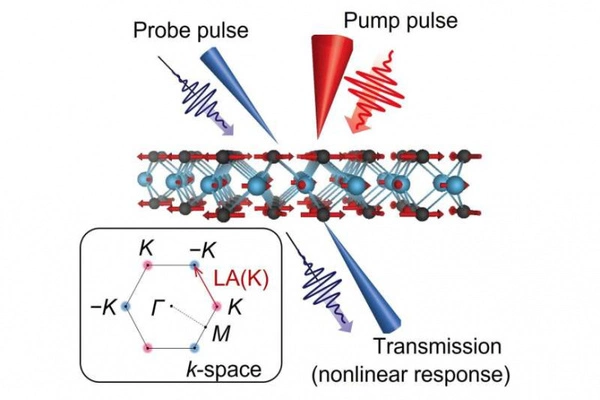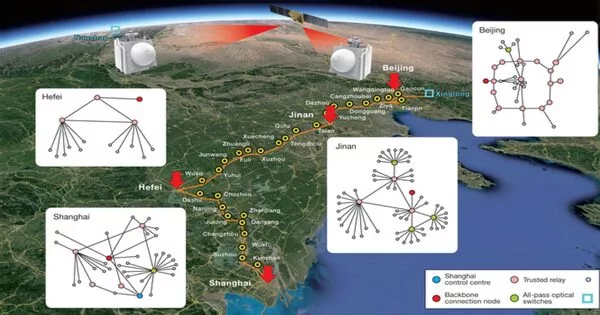An experimental demonstration of a space-to-ground quantum key distribution (QKD) network using a compact QKD terminal aboard the Chinese Space Lab Tiangong-2 and four ground stations is reported by researchers. The new QKD system weighs less than half as much as the system developed by the researchers for the Micius satellite, which was used to conduct the world’s first quantum-encrypted virtual teleconference.
The demonstration is a significant step toward practical QKD based on constellations of small satellites, which is regarded as one of the most promising approaches to establishing a global quantum communication network.
“QKD provides unconditional security by encoding information between two distant terminals using single photons,” said Cheng-Zhi Peng of the University of Science and Technology of China. “By allowing the use of small satellites, the compact system we developed can reduce the cost of implementing QKD.”
Peng and colleagues from other Chinese institutions describe their new system and experimental results in Optica, the journal for high-impact research published by the Optica Publishing Group. They also discovered that QKD performance can be improved by constructing a network of satellites orbiting at different angles, or inclinations, to the equator.
Our new work demonstrates the feasibility of a space-ground QKD network based on a compact satellite payload combined with constellations of satellites with different orbit types. In the near future, this type of QKD system could be used in applications that require high security such as government affairs, diplomacy and finance.
Cheng-Zhi Peng
“Our new work demonstrates the feasibility of a space-ground QKD network based on a compact satellite payload combined with constellations of satellites with different orbit types,” said Peng. “In the near future, this type of QKD system could be used in applications that require high security such as government affairs, diplomacy, and finance.”
Shrinking the QKD system
QKD uses the quantum properties of light to generate secure random keys for encrypting and decrypting data. In previous work, the research group demonstrated satellite-to-ground QKD and satellite-relayed intercontinental quantum networks using the Micius satellite. However, the QKD system used aboard that satellite was bulky and expensive. About the size of a large refrigerator, the system weighed around 130 kg and required 130 W of power.
As part of China’s quantum constellation plan, the researchers sought to develop and demonstrate a more practical space-ground QKD network. To do this, they developed a compact payload that allowed the Tiangong-2 Space Lab to act as a satellite QKD terminal. The QKD payload – consisting of a tracking system, QKD transmitter, and a laser communication transmitter – weighed around 60 kg, required 80 W of power, and measured about the size of two microwave ovens.

“This payload was designed to be as integrated as possible in order to reduce volume, weight, and cost while achieving the high performance required to support space-to-ground QKD experiments,” Peng explained. “It also had to be extremely tough in order to withstand harsh conditions like the severe vibration experienced during launch and the extreme thermal vacuum environment of space.”
Between October 2018 and February 2019, the researchers conducted 19 QKD experiments in which secure keys were successfully distributed between the Space Lab terminal and four ground stations on 15 different days. To avoid the influence of daylight background noise, these experiments were carried out at night.
The researchers found that the medium (~42°) inclination orbit of the space lab allowed multiple passes over a single ground station in one night, which increased the number of keys that could be generated. They also built a model to compare the performance of satellite-based QKD networks with different orbit types. They found that combining satellites with a medium-inclination orbit like the space lab with a sun-synchronous orbit that travels over the polar regions achieved the best performance.
Next steps
The researchers are currently working to improve their QKD system by increasing its speed and performance, lowering its cost, and investigating the feasibility of daytime satellite-to-ground QKD transmission. “These advancements would enable the creation of a practical quantum constellation by launching multiple low-orbit satellites,” said Peng. “To create a space-ground-integrated quantum network, the constellation could be combined with a medium-to-high-orbit quantum satellite and fiber-based QKD networks on the ground.”
On July 27, an even smaller quantum satellite developed by Hefei National Laboratory, the University of Science and Technology of China, and other Chinese research institutes was successfully launched into space. This satellite, known as a micro/nano satellite, is about one-sixth the size of the Micius satellite and contains a QKD system about one-third the size of the one demonstrated in the Optica paper. That satellite is intended to conduct real-time satellite-to-ground QKD experiments, marking yet another significant step toward low-cost and practical quantum satellite constellations.





